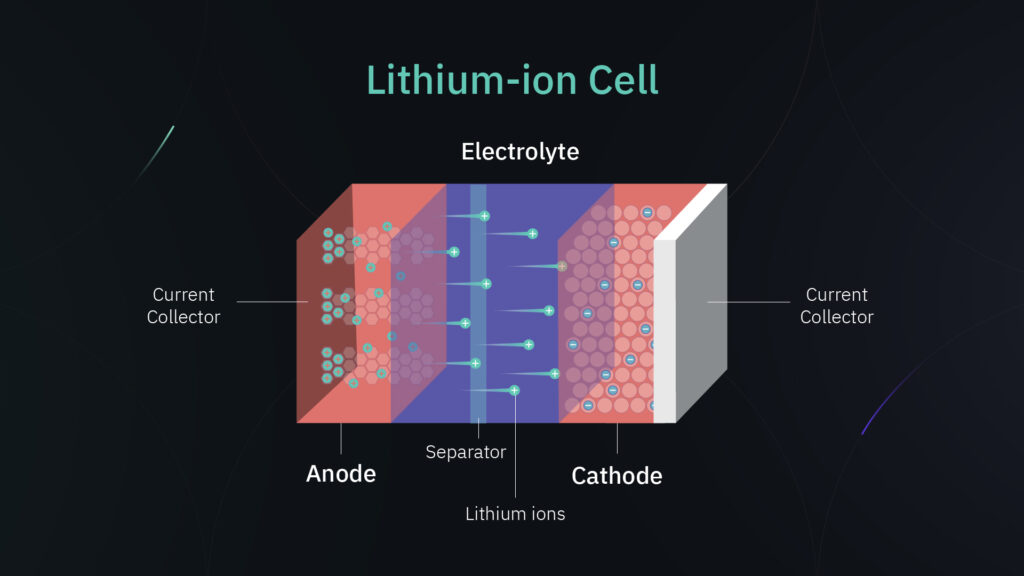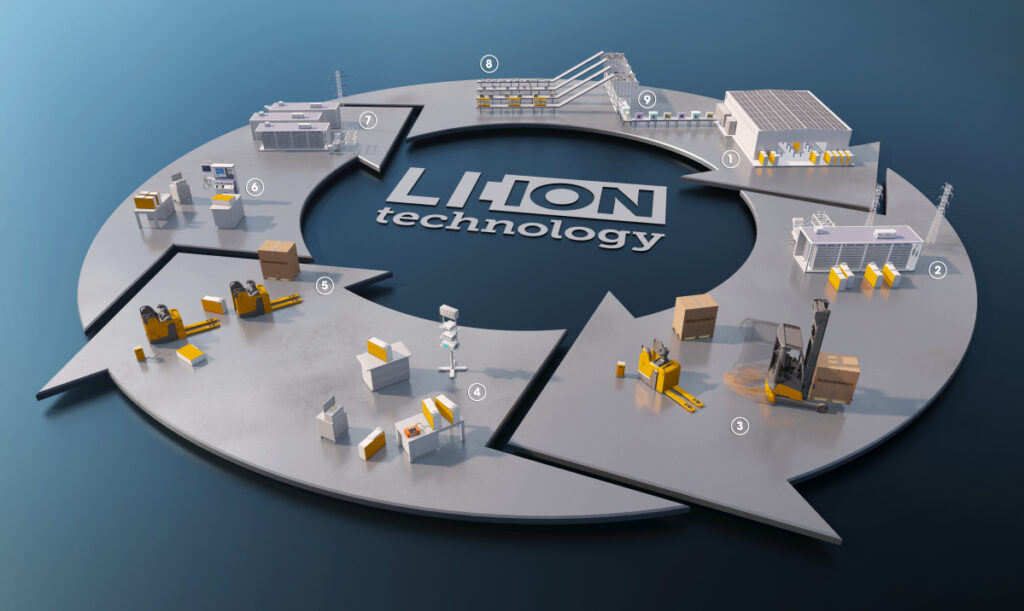Lithium-ion, or Li-ion, is a technology dethroning traditional lead-acid cells in major industries. Most electronic devices are powered by these batteries, from mobile phones to cameras to automated vehicles. In this blog post, we will uncover what these power cells are and how they have paved the way to become the leading energy source in intralogistics.
Lithium-ion batteries are a key enabler of the mobile device world. They have been a prevalent choice in consumer electronics due to their unique selling points: lightweight, high energy density, and maintenance-free. Because of these characteristics, in recent years Li-ion cells have become the number one choice of manufacturers from other industries, including aerospace, electric vehicles, and intralogistics.
Lithium-ion batteries significantly affect the performance of automated warehouse vehicles, such as forklifts, autonomous mobile robots (AMRs), and automated guided vehicles (AGVs). They are, therefore, a primary source of power for the intralogistics industry. “Li-ion batteries are one of the primary factors that impact the performance of AMRs. The traditional energy storage solutions are big and heavy in weight. Hence, our project, the arculee, would never have come this far without this technology.”, says Carlo Fitz (Managing Director at arculus) in an interview with DW.
Understanding the mechanism behind Lithium-ion batteries
To better understand how lithium-ion batteries work, it’s essential to examine their fundamental components. The lithium ions are electrically charged particles that move in the battery to generate an electric current. The cathode, or positive electrode, serves as the primary source of lithium ions and determines the battery’s voltage.
During charging, the anode, or negative electrode, triggers an electric current to pass through the external circuit and stores lithium ions. A thin insulating material called a separator prevents electrons from passing between the cathode and anode while lithium ions move through. Lastly, the electrolyte, which consists of a liquid mixture of salts, solvents, and additives, is responsible for conducting electricity.

As the name implies, the functioning of lithium-ion batteries revolves around the movement of lithium ions. During the charging process, the cathode releases lithium ions (Li+) which move through the electrolyte and get stored in the anode, allowing the battery to accumulate energy. At the same time, electrons flow through the external circuit from the positive to the negative electrode. Once the movement of lithium ions and electrons ceases, it indicates that the battery is fully charged and ready to be used.
In contrast, during discharging, the ions flow in the opposite direction, from the negative to the positive terminal through the electrolyte. Electrons follow the same direction as ions through the outer circuit to power the device. When all the ions move back, the battery is fully discharged and must be charged again.
Lithium-ion batteries versus lead-acid batteries
While Li-ion power packs are emerging as a top pick, lead-acid batteries are on the way to becoming obsolete. Taking a closer look specifically at intralogistics, here’s how lithium-ion batteries have the edge over their lead-acid counterparts:
High energy density:
Lithium-ion batteries are extremely powerful, usually with an energy density between 100 and 265 watt-hours per kilogram. High energy storage makes them a more stable and faster powering source than lead-acid batteries. This is crucial to enable automated vehicles to carry out complex tasks in multi-shift operations.
Furthermore, Li-ion batteries typically do not need any backup, because they go into charging mode between shifts. This means users don’t need to remove the cells from the automated vehicles for charging, which saves time and costs.
No maintenance, lower costs:
Another way in which Li-ion batteries save cost and money is by ensuring that end-users don’t have to worry about maintenance. Compared to lead-acid cells that need to be refilled with electrolytes or demand a separate infrastructure, Li-ion technology has no such requirement, thus offering a hassle-free solution.
Low self-discharge:
Most batteries, including lead-acid cells, lose their charge when disconnected from the device. But that’s not the case with Li-ion batteries. These rechargeable cells have a substantially low self-discharge rate, and, if fully charged, can retain power much longer without causing any damage to themselves.
Emission-free:
Automation fosters green intralogistics, and the use of lithium cells in automated vehicles can boost sustainability efforts. They do not release dangerous gases during operation or charging, reducing carbon emissions in electric vehicles by around 20%.
Higher Usable Capacity
Compared to conventional solutions, Li-ion batteries have a higher usable capacity, with a discharge range of 80-100%. The result is more consistent power, allowing vehicles to operate longer on a single charge.

Benefits of using Li-ion batteries in the arculee
Li-ion technology is one of the key factors that enable the sophisticated capacities of our AMR. For starters, these batteries allow the arculee to operate for eight uninterrupted hours on a single charge. Additionally, Li-ion cells can communicate with smart systems and provide real-time updates about the time remaining before the battery is fully discharged. This feature ensures that the arculee has sufficient time to automatically reach the nearest charging station.
The future is lightning
Batteries have become a large part of our mobile world, and Lithium-ion technology is here to stay. According to a report by Mckinsey, nearly 60% of lithium is extracted for producing batteries today, and this number can potentially rise to 95% in the near future.
arculus is an early adopter of this technology. Its advanced characteristics enable our AMR to transport heavy loads more efficiently and with minimum interruptions in the warehouse. Thanks to Li-ion batteries, we are proud to offer a solution that helps customers reduce costs and operate more sustainably.
The Lithium-Ion Story by Deutsche Welle
A documentary film by Deutsche Welle explores the extraction of lithium, the production of state-of-the-art cells and their use in Jungheinrich vehicles, including the arculee (from minute 38:28). Watch it below: